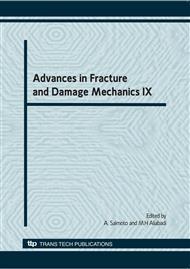[1]
L. Lefebvre, J. Banhart, D.C. Dunand, Porous metals and metallic foams: current status and recent developments. Advanced Engineering Materials, 10(9) (2008), 775-787.
DOI: 10.1002/adem.200800241
Google Scholar
[2]
U. Ramamurty, A. Paul, Variability in mechanical properties of a metal foam. Acta materialia, 52 (2004), 869-876.
DOI: 10.1016/j.actamat.2003.10.021
Google Scholar
[3]
L. Peroni, M Avalle, M. Peroni, The mechanical behaviour of aluminium foam structures in different loading conditions, Int. J. of Impact Engineering, 35 (2008), 644-658.
DOI: 10.1016/j.ijimpeng.2007.02.007
Google Scholar
[4]
C. Chen, A-M Harte, N.A. Fleck, The plastic collapse of sandwich beams with a metallic foam core, Int. J. of Mechanical Sciences, 43 (2001), 1483-1506.
DOI: 10.1016/s0020-7403(00)00069-2
Google Scholar
[5]
J.F. Rakow, A.M. Waas, Size effects and the shear response of aluminium foam, Mechanics of Materials, 37 (2005), 69-82.
DOI: 10.1016/j.mechmat.2003.12.002
Google Scholar
[6]
T.J. Lu, J.M. Ong, Characterization of close-celled cellular aluminum alloys, J. of Materials Science, 36 (2001), 2773 - 2786.
Google Scholar
[7]
C. Chen, N.A. Fleck, Size effects in the constrained deformation of metallic foams, J. of the Mechanics and Physics of Solids, 50 (2002), 955-977.
DOI: 10.1016/s0022-5096(01)00128-4
Google Scholar
[8]
B. Zettl, H. Mayer, S.E. Stanzl Tschegg, H.P. Degischer, Fatigue properties of aluminium foams at high numbers of cycles. Material Science and Engineering A, 292 (2000), 1-7.
DOI: 10.1016/s0921-5093(00)01033-9
Google Scholar
[9]
A.M. Harte, N.A. Fleck, M.F. Ashby, Fatigue failure of an open cell and a closed cell aluminium alloy foam, Acta materialia, 47 (1999), 2511-2524.
DOI: 10.1016/s1359-6454(99)00097-x
Google Scholar
[10]
C. Motz, R. Pippan, Fracture behaviour and fracture toughness of ductile closed-cell metallic foams, Acta Materialia, 50 (2002), 2013-(2033).
DOI: 10.1016/s1359-6454(02)00047-2
Google Scholar
[11]
R.P. Onck, R. Van Merkerk, A. Raaijmakers, J.T.M. De Hosson, Fracture of open- and closed-cell metal foams, Journal of Material Science, 40 (2005), 5821-5828.
DOI: 10.1007/s10853-005-4996-7
Google Scholar
[12]
P.S. Liu, Tensile fracture behavior of foamed metallic materials, Material Science and Engineering A, 384 (2004), 352-354.
DOI: 10.1016/j.msea.2004.06.038
Google Scholar
[13]
V. Dattoma, N. I . Giannoccaro, A. Messina, R. Nobile, Prediction of residual fatigue life of aluminium foam through natural frequencies and damping shift, Fatigue and Fracture of Engineering Materials and Structure, 32 (2009), 601-616.
DOI: 10.1111/j.1460-2695.2009.01367.x
Google Scholar


